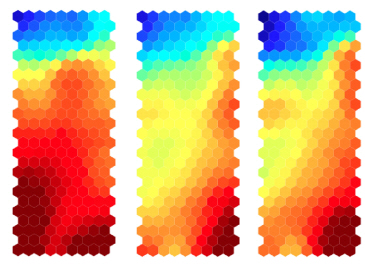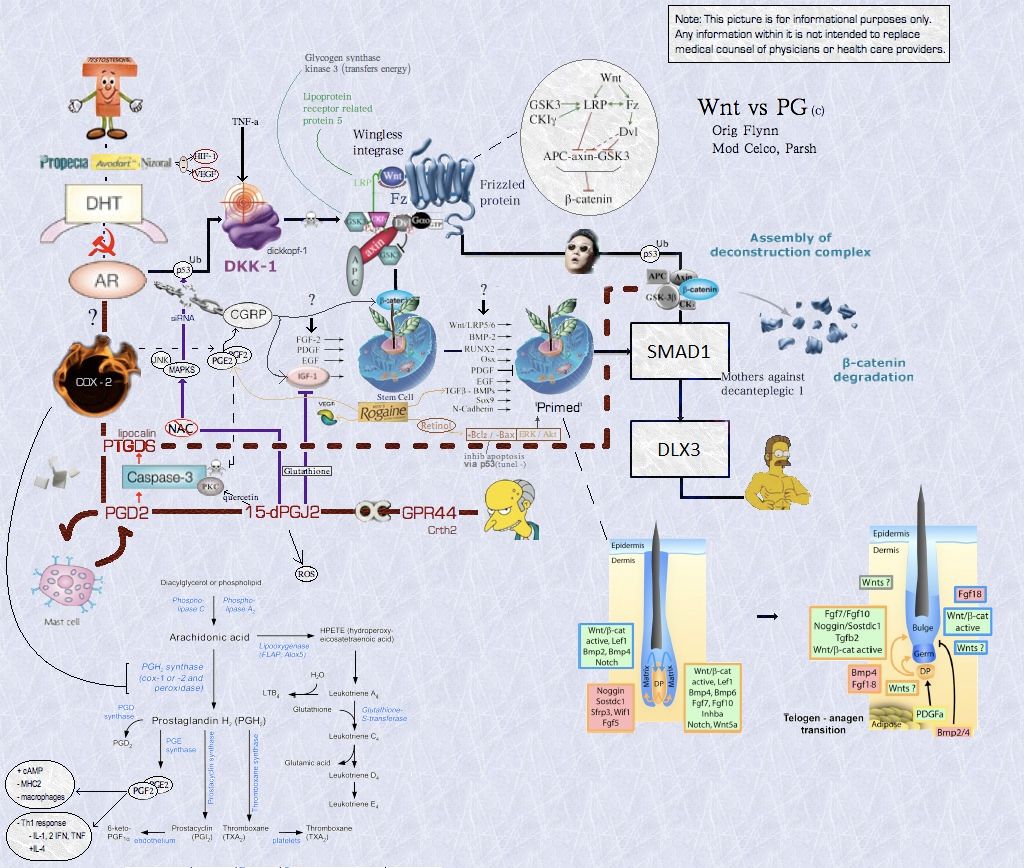I was just reading up on MPB and what causes it, and there are definitely links to autoimmune disorders.
Mast cells are one interesting aspect. They are shown to exist in much higher numbers in bald scalp. Mast cells exist next to the hair follicle, and interact with hair follicle cells. They are basically cells that release histamines and other things(which in turn cause an allergic inflammatory reaction, and also cause fibrosis) Mast cells also release PGD2 and serotonin (SSRI drugs, which keep more serotonin in the bloodstream, have been implicated in hair loss as a side effect). PGD2 we all know also causes hair loss.
"Mast cells may be implicated in the pathology associated with autoimmune, inflammatory disorders of the joints. They have been shown to be involved in the recruitment of inflammatory cells to the joints (e.g., rheumatoid arthritis) and skin (e.g., bullous pemphigoid), and this activity is dependent on antibodies and complement components.[19]"
This is probably why Replicel's healthy DSC cells work for tendonitis. They somehow reduce mast cell activity or release factors that do the opposite of histamines and other molecules.
There's also something going on with alcohol and baldness. It's been proven that homeless alcoholic men have less incidence of baldness (i see evidence of it every day). EtOH (ethanol) has been shown to bind with the androgen receptor. Also, finasteride has been shown to reduce cravings for alcohol. One theory is that finasteride reduces the production of neurosteroids, which cause cravings for alcohol. Steroids like hydrocortisone also bind to the androgen receptor and reduce inflammation. Maybe alcoholic men tend to have more neurosteroids and thus their androgen receptors are less prone to connect to DHT?? Either way it all points back to the immune response again. DHT causes hair follicle cells to produce MHC II cells, which in turn facilitate the recognition of antigens by T cell receptor sites on cells. (antigens tell the body to destroy cells, such as hair cells). In alopecia areata, T cells destroy the hair follicle. Is it possible that in MPB, T Cells are also implicated? Or maybe it is the mast cells that are forced into action by the MHC II cells. Mast cells and T cells are known to communicate and activate each other. Either way, it seems that an immune system related reaction is what causes the follicle to undergo apoptosis.
I think Christiano is on the right track, but maybe there's something missing in the puzzle. I think drugs like CB that bind to the androgen site or finasteride which reduces the amount of DHT made are only working on the outermost layer of the problem. I don't think PGD2 blockers are the answer, because PGD2 is only one element that causes this immune response. It seems to me that a permanent cure lies in reprogramming the hair cells to break their communication with the immune response. What is the antigen involved in MPB? Is there one?
I think that a topical version of what they are suing in Areata could in fact help in suppressing MPB. I'm curious for someone to try it. The problem is that with MPB, androgens keep telling the hair cells to activate the genes that cause this similar immune response, whereas in Areata, they are basically fixing the "trigger". Maybe the ultimate answer for MPB is a similar fix of the immune response combined with a blocking of the androgen receptor. I'm really curious to know what researchers have to say about all this.
On a side note- I wonder if Christiano has looked into the same drugs in order to treat Vitiligo. It seems that skin discoloration is also caused by these same autoimmune issues. I bet that if they administered the drug to vitiligo patients it would have a positive effect. just a guess.
This news also seems very related and relevant, and I wonder if it can be applied to MPB as well:
Mast cells are one interesting aspect. They are shown to exist in much higher numbers in bald scalp. Mast cells exist next to the hair follicle, and interact with hair follicle cells. They are basically cells that release histamines and other things(which in turn cause an allergic inflammatory reaction, and also cause fibrosis) Mast cells also release PGD2 and serotonin (SSRI drugs, which keep more serotonin in the bloodstream, have been implicated in hair loss as a side effect). PGD2 we all know also causes hair loss.
"Mast cells may be implicated in the pathology associated with autoimmune, inflammatory disorders of the joints. They have been shown to be involved in the recruitment of inflammatory cells to the joints (e.g., rheumatoid arthritis) and skin (e.g., bullous pemphigoid), and this activity is dependent on antibodies and complement components.[19]"
This is probably why Replicel's healthy DSC cells work for tendonitis. They somehow reduce mast cell activity or release factors that do the opposite of histamines and other molecules.
There's also something going on with alcohol and baldness. It's been proven that homeless alcoholic men have less incidence of baldness (i see evidence of it every day). EtOH (ethanol) has been shown to bind with the androgen receptor. Also, finasteride has been shown to reduce cravings for alcohol. One theory is that finasteride reduces the production of neurosteroids, which cause cravings for alcohol. Steroids like hydrocortisone also bind to the androgen receptor and reduce inflammation. Maybe alcoholic men tend to have more neurosteroids and thus their androgen receptors are less prone to connect to DHT?? Either way it all points back to the immune response again. DHT causes hair follicle cells to produce MHC II cells, which in turn facilitate the recognition of antigens by T cell receptor sites on cells. (antigens tell the body to destroy cells, such as hair cells). In alopecia areata, T cells destroy the hair follicle. Is it possible that in MPB, T Cells are also implicated? Or maybe it is the mast cells that are forced into action by the MHC II cells. Mast cells and T cells are known to communicate and activate each other. Either way, it seems that an immune system related reaction is what causes the follicle to undergo apoptosis.
I think Christiano is on the right track, but maybe there's something missing in the puzzle. I think drugs like CB that bind to the androgen site or finasteride which reduces the amount of DHT made are only working on the outermost layer of the problem. I don't think PGD2 blockers are the answer, because PGD2 is only one element that causes this immune response. It seems to me that a permanent cure lies in reprogramming the hair cells to break their communication with the immune response. What is the antigen involved in MPB? Is there one?
I think that a topical version of what they are suing in Areata could in fact help in suppressing MPB. I'm curious for someone to try it. The problem is that with MPB, androgens keep telling the hair cells to activate the genes that cause this similar immune response, whereas in Areata, they are basically fixing the "trigger". Maybe the ultimate answer for MPB is a similar fix of the immune response combined with a blocking of the androgen receptor. I'm really curious to know what researchers have to say about all this.
On a side note- I wonder if Christiano has looked into the same drugs in order to treat Vitiligo. It seems that skin discoloration is also caused by these same autoimmune issues. I bet that if they administered the drug to vitiligo patients it would have a positive effect. just a guess.
This news also seems very related and relevant, and I wonder if it can be applied to MPB as well:



 .
.
 keep it coming!
keep it coming!
 Areata does seem to be a much more straightforward disease, but hopefully we will get a drug in the near future that is better than propecia. I don't know if researchers are really focused on untangling these pathways at this point, I think most of them are more excited about stem cell research.
Areata does seem to be a much more straightforward disease, but hopefully we will get a drug in the near future that is better than propecia. I don't know if researchers are really focused on untangling these pathways at this point, I think most of them are more excited about stem cell research.

Comment